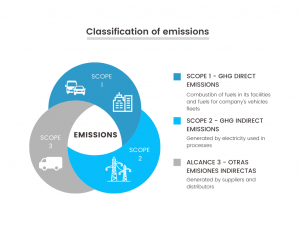With ClimateTrade, organizations can easily calculate their carbon footprint.
Faced with the heated discussion about the climate crisis and the urgency of taking effective actions to reduce the consequences of global warming, many companies are beginning to work on their ESG (Environmental, Social and Government) objectives. Among which is the “calculation of the carbon footprint”, which allows them to visualize a clear panorama of the impacts caused to the environment resulting from their business models.
Calculate carbon footprint
In a net zero world, every company will be required to calculate and offset its carbon footprint via different CO2 emissions offsetting projects.
In many countries, large companies in polluting sectors are already asked to do so by law, and by the end of this decade, this requirement will be extended to many more countries, sectors, and types of companies. In other words, now is the time to prepare for this obligation.
Do you need help to calculate the carbon footprint of your company? Fill in the form and a ClimateTrade expert will contact you.
What is the carbon footprint?
The carbon footprint is the sum of all the greenhouse gases a person, company or even country releases into the atmosphere, expressed in CO2 equivalent. These emissions are responsible for global warming, and as such, they need to be addressed in the fight against climate change. This is why many governments are putting a limit on the amount of emissions companies can produce, which is often combined with a tax on carbon. Many countries and companies have pledged to be net zero by 2050, which means that all their carbon emissions will be offset, and none will enter the atmosphere and destabilize the climate.
Calculating the carbon footprint of a company means assessing its impact on the climate. It is a necessary step in combating climate change at company level.
Methodology to calculate CO2 emissions
Whatever your sector is, it is crucial to follow standard methodology to calculate your carbon footprint. This will ensure you are aligned with industry best practices, and make it easier to report and offset your emissions.
Greenhouse Gas Protocol
The most widely used methodology to calculate carbon footprint, whether manually or through a carbon footprint calculator, is that of the Greenhouse Gas Protocol (GHG Protocol). The first edition of this standard was published in 2001 after a decade of international cooperation. In 2016, 92% of Fortune 500 companies reported using this standard for carbon emissions calculation.
The GHG Protocol offers several relevant methodologies: The Corporate Accounting and Reporting Standard is its generic guidance for companies and other organizations preparing a corporate-level GHG emissions inventory; the Corporate Value Chain Standard focuses on scope 3 calculation and reporting; and the Product Life Cycle Standard can be used to understand the full life cycle emissions of a product and focus efforts on the greatest GHG reduction opportunities.
Emissions classification to calculate carbon footprint
With this protocol, emissions can be classified into three areas:
Scope One: Direct GHG Emissions
Scope 1 emissions are those generated by a company’s own operations.
For instance, for oil and gas companies, scope 1 represents a very large share of the carbon footprint: their core activities of drilling, extracting and refining petrol and natural gas release large amounts of greenhouse gases into the atmosphere.
On the other hand, service-oriented companies such as banks and financial institutions tend to have small amounts of scope 1 emissions, since they work in offices and don’t use polluting processes to make their products.
To calculate your scope 1 emissions, think about what you and your employees do on a daily basis. Where do you work (office, factory, field, etc.)? What do you do? How polluting are your daily activities?
Scope Two: Indirect GHG emissions associated with electricity
These are indirect GHG emissions generated by electricity, process heat or cold, or steam used in processes, as well as transportation. They can begin to be counted from the invoices of the energy supply companies with the breakdown of the kilowatt-hours, therms or cubic meters that they supply.
All sectors require electricity to operate, so all companies need to calculate scope 2 emissions. Start with your power supply: how much of it comes from renewable sources, and how much from fossil fuels? How much power do you use for your operations on a yearly basis? This will help you assess how much of your carbon footprint comes from electricity.
The same exercise applies to heating or even cooking: companies often use natural gas for these activities, so it is important to calculate the emissions related to them.
Then, look at transportation: does your company operate a fleet? Do your vehicles have combustion engines or are they electric? What kind of distance do they drive every week, month or year? This information will allow you to calculate the emissions related to the transportation fuel you use for your operations.
Scope Three: Other indirect emissions
Scope 3 emissions can be considered “out of your control”: they include the emissions generated by your providers and by your clients in the lifecycle of your product or service.
For instance, going back to oil and gas companies, while the extraction and refining of the raw material belongs to scope 1, the combustion of these products in everyday activities such as driving or cooking are part of their scope 3.
This is why the general carbon footprint calculation methodology includes scope 3: companies have to make changes and incentivize decarbonization throughout their supply chains.
What to include in the Scope 3 carbon footprint of an organization?
In particular, it is recommended to include:
- emissions from the means of transport used by workers between their residence to their workplace
- emissions from business trips by executives or middle managers, especially flights, trips by private or rented car, hotel stays, boat or ferry trips
- emissions from outsourced computing services, such as cloud services
- the emissions of the logistics companies collecting or delivering the products
It is worth noting that Scope Three emissions in certain sectors is the largest source of emissions, especially by suppliers, distributors or carriers.
To help companies conceptually with the calculation of the CO2 footprint, the main activity carried out in their own facilities is divided into “upstream” and “downstream” activities.
Upstream emissions
Upstream emissions include those that occur in the life cycle of a product: purchase and delivery of raw materials or components, manufacturing and exit from the manufacturer or producer’s facilities.
Downstream emissions
Downstream emissions occur in the life cycle of a product after sale, including distribution and storage, use of the product and disposal at the end of its useful life.
CO2 emissions by sector
While the three scopes described above are common to all sectors and company sizes, there will be some differences in carbon footprint calculation depending on which industry you work in. This is also reflected in the methodologies used by carbon footprint calculators.
Mobility
In the mobility sector, the bulk of the carbon footprint comes from the combustion of fossil fuels for driving. This is why many operators have switched to hybrid or even electric fleets in an effort to move towards carbon-neutral mobility.
Check out what Cabify is doing to achieve carbon neutrality.
Aviation
Similarly to mobility, the aviation sector’s carbon footprint also comes largely from fossil fuel combustion – except there is currently no electric alternative. While they wait for zero carbon fuels such as green hydrogen to be commercially available, airlines have no choice but to offset their carbon footprint.
Find out how Iberia is allowing its clients to offset the footprint of their flights.
Construction
To decarbonize its operations, the construction sector has to calculate emissions from “cradle” (the extraction of raw materials used to build the building) to “grave” (the demolition of the building and approach to reusing, recycling and disposing of materials). This is called the carbon footprint assessment or lifecycle carbon measurement. Construction is a notoriously difficult industry to decarbonize, but many companies and associations are taking measures to calculate and offset the carbon footprint of buildings.
Read about the work ITeC is doing to offset the carbon footprint of buildings.
Tourism
Tourism is a wide and varied sector including accommodation and many different types of experiences. In the hotel sector, calculating carbon emissions mostly involves assessing the carbon footprint of the building itself (see construction), and its energy use. But let’s not forget that hotels often serve breakfast and other meals, which means cooking fuel and scope 3 emissions from food production.
Learn about Melia Hotels’ carbon offsetting initiative.
Financial services
As mentioned above, the financial sector tends to have a small scope 1 and 2 carbon footprint, mostly coming from its offices and electricity use. Many companies in this space already offset the carbon footprint of their operations. However, banks and other financial institutions provide the funding necessary for all kinds of activities, from mining to manufacturing and retail. That’s why scope 3 emissions are the most significant share of their footprint.
See how Santander Bank is tackling scope 3 emissions from customers.
Events
There are four main areas to take into account in calculating the emissions associated with an event: travel, accommodation, venue and food. How far do your speakers and attendees have to travel to come to your event, and how will they travel? Where are they staying, and for how long? Where are you having your event, and what is the energy consumption of this venue? And finally, what kind of food are you serving?
Read our guide to carbon-neutral events.
Automated carbon footprint calculators
Little by little, innovators around the world are building automated carbon footprint calculators to support companies’ decarbonization efforts. ClimateTrade has developed sector-specific calculators for construction, airlines and mobility, and offers calculation services for events and general industries. All our carbon footprint calculators follow the methodology of the GHG Protocol.
Get in touch to find out more.
Calculate carbon footprint to offset it
Once you have calculated the carbon footprint of your company, it is time to reduce and offset it. Reduction measures can include switching to a renewable energy provider or implementing energy efficiency measures. But it is currently impossible to reduce a company’s carbon footprint to zero. This is why most companies opt to offset their remaining carbon emissions.
ClimateTrade offers a marketplace where companies can browse certified carbon mitigation projects and purchase carbon credits to offset their footprint. Our platform is based on blockchain, which means all transactions are fully traceable – giving companies the comfort of knowing that their money is creating real impact.
Register for free to start browsing projects.
API ClimateTrade: manage and calculate carbon footprint

Thanks to decentralized blockchain technology, consensus and clear rules are generated between suppliers and a control dashboard can be used to encourage suppliers to be carbon neutral through the purchase of online offsets. In the ClimateTrade marketplace, the members of the supply chain can offset scope one through EUAs emission rights, and in the case of scope two with renewable energy certificates of origin such as IRECs.
Interested? Complete your registration and talk to our experts.
Do you need help to calculate the carbon footprint of your company? Fill in the form and a ClimateTrade expert will contact you.








